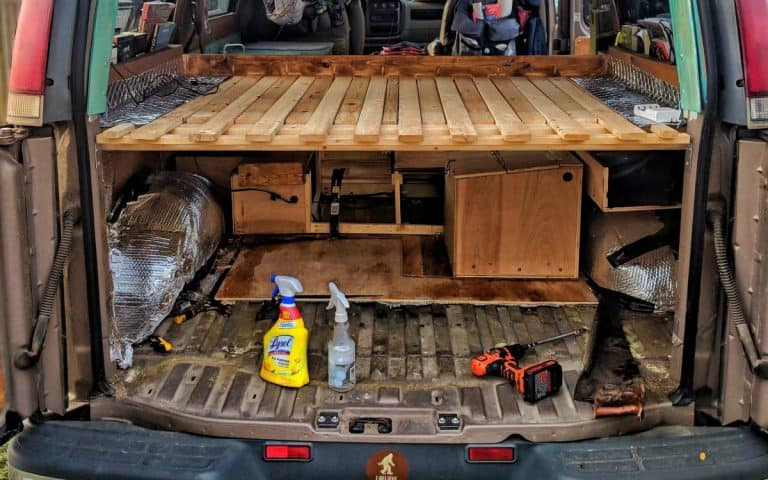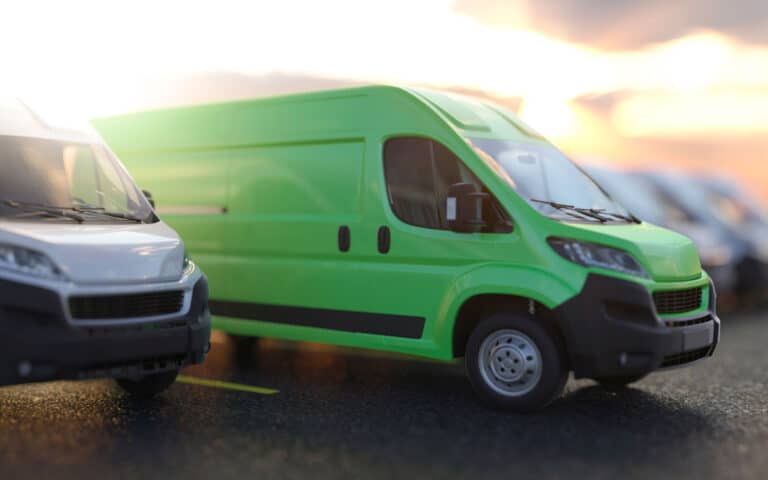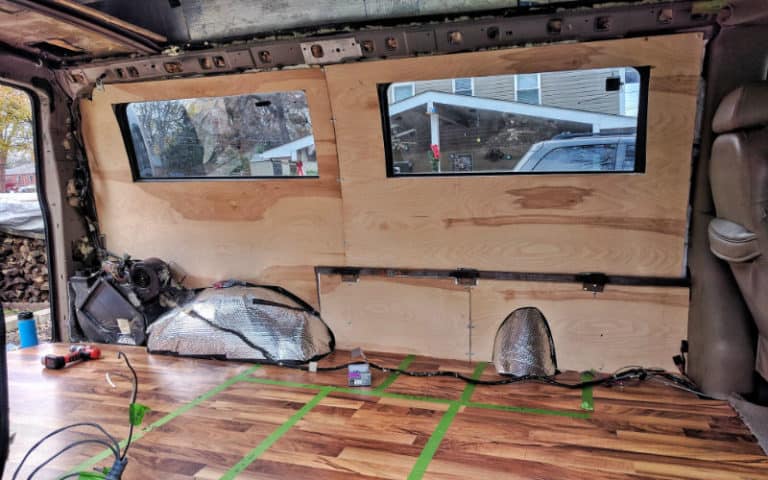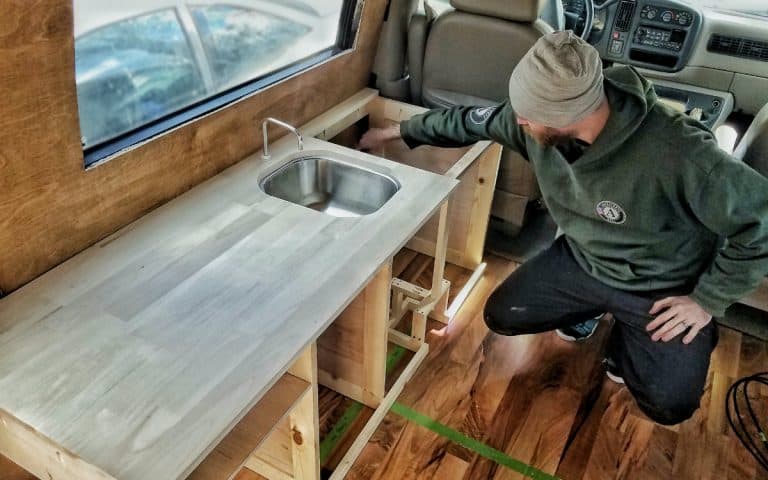If you’re hunting for a power inverter for your off grid, RV, or camper van solar system, you’ve probably noticed that there are two different types of inverters.
- Modified sine wave inverters are much cheaper to buy, but they produce a “dirtier” electrical signal that can shorten the lifespan, reduce the efficiency, and even damage some types of appliances. Modified sine inverters are also less efficient to run.
- Pure sine wave inverters are more expensive, but the “clean” electrical signal they create is equivalent to what comes out of a wall socket in your home. Pure sine inverters are more efficient to run, and can power all types of sensitive electronics.
Which type of inverter should you choose? While this depends on your electrical system and what you’re powering, in most cases you’ll want to choose a pure sine wave inverter, especially if you’re using it as a main power source in a campervan, RV, or tiny home. If you just need to power basic electronics on a camping trip or road trip, modified sine is fine.
In this post, we examine the differences between these types of inverters, how they generate AC power, the benefits and limitations of each, and which one to go with for your situation.
Bottom Line: If you’re building an electrical system for your camper van, RV, or off-grid dwelling, going with a pure sine wave inverter is the clear choice. Modified sine wave inverters are fine for more limited applications, but if your goal is to power your entire living situation, just go with pure sine.
This post is adapted from our ebook Vanlife Solar Basics.
Are you tired of jumping from website to website trying to wrap your head around your van’s electrical system? Our comprehensive guide covers everything from fundamentals to components to sizing to installation, all in one easy-to-follow package.
What is a Power Inverter?
An inverter takes direct current (DC) electricity and converts it to alternating current (AC) electricity.
The electrical current produced by your solar panels and stored in your van’s batteries is known as direct current, or DC. Direct current flows at a constant voltage (12V in the case of most campervans and RVs), and the DC waveform basically looks like a flat line.
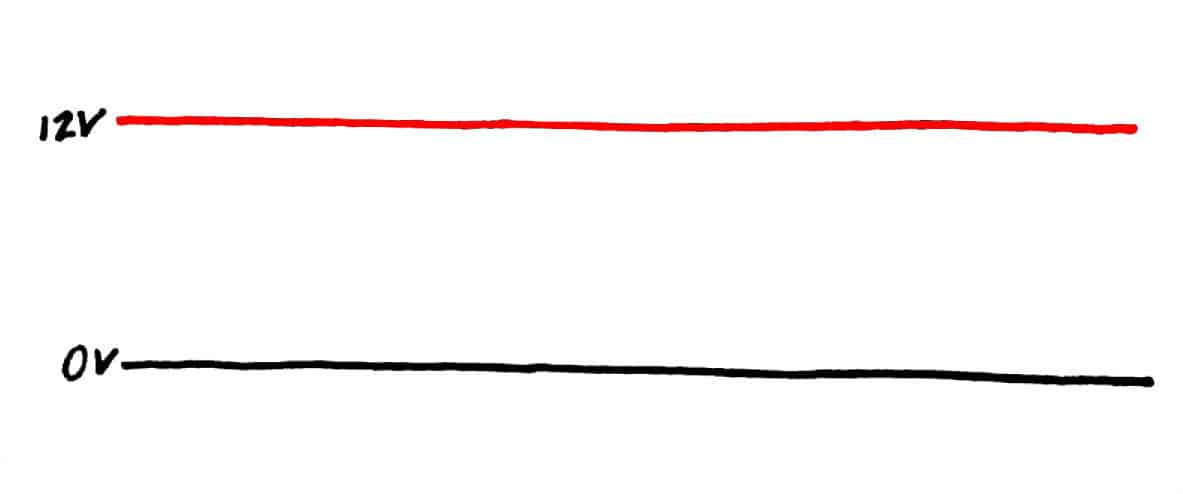
You can power most things in your van with 12V DC, including your lights, vanlife refrigerator, vent fan, and 12V outlets.
But direct current is not what comes out of your typical wall outlet – that’s alternating current, or AC.
Alternating current produces a signal that alternates above and below 0V, ultimately outputting the voltage that you need to power most standard household electronics (110V/120V in North America, 220V/240V in many other countries).
The AC waveform looks like smooth waves alternating between positive and negative voltage.
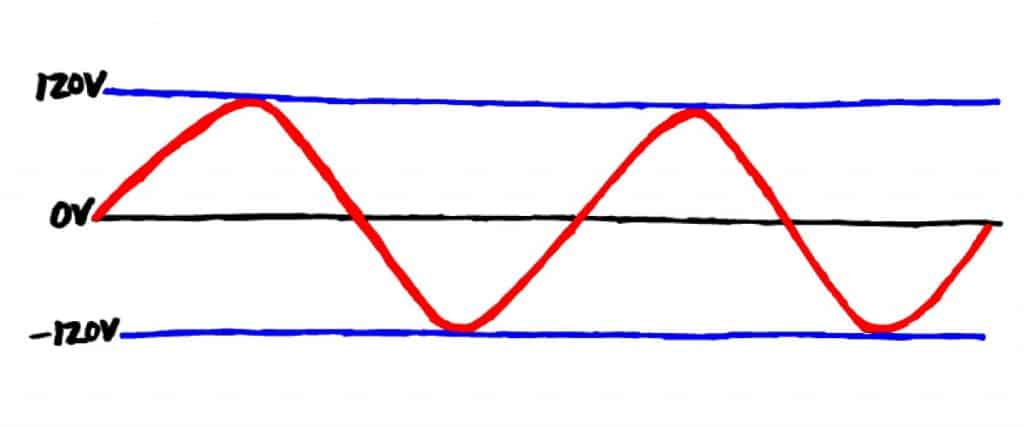
If you want to power appliances that use a regular wall plug, you’ll need to convert the DC current from your batteries to AC current. This is where the power inverter comes in.
However, not all AC current is created equal. When choosing the best inverter for your van, you need to understand the two different types of inverters and how they create AC power.
Modified Sine Wave AC Current
Modified sine wave inverters create alternating current by producing a stepped, blocky signal that jumps above and below 0V in boxy shapes.
This is not “pure” alternating current, but rather an approximation of the sine wave that makes up clean AC.
A modified sine waveform looks something like this:

Inverters that produce a modified sine wave are capable of powering most AC devices, but they may cause some issues, which we’ll get into further down.
Note: Modified sine wave inverters are also referred to as “stepped sine” or “multi-step wave” inverters.
Pure Sine Wave AC Current
Pure Sine Wave Inverters produce a smooth sine wave that is equivalent to the “clean power” you get from the electric grid.
The waveform looks something like this:

You’ll notice that this smooth waveform looks exactly like the waveform for AC current in general, which ultimately means that AC appliances run better on a pure sine wave inverter.
The AC current from a pure sine wave inverter is much more consistent and reliable, so these inverters are able to run sensitive electronics just as well as the wall outlet in a grid-connected house.
Note: Pure sine inverters are also referred to as “True Sine Wave” inverters.
Modified Sine Wave vs Pure Sine Wave Inverters
The major differences between modified sine wave and pure sine wave inverters comes down to device compatibility, efficiency, and cost.
| Pure Sine Wave Inverters | Modified Sine Wave Inverters | |
|---|---|---|
| Waveform | Smooth and continuous like AC grid power | Blocky, approximates a sine wave |
| Compatibility | Ideal for sensitive electronics | Suitable for basic electronics only |
| Efficiency | High (>90%) | Lower compared to pure sine wave |
| Cost | More expensive | More affordable |
Device Compatibility
Because pure sine wave inverters produce clean AC current that mimics the smooth and continuous waveform of the electrical grid, they are capable of powering all types of electrical devices without issue. These types of inverters are ideal for sensitive electronics like medical devices, CPAP machines, induction cooktops, and computers.
Modified sine wave inverters generate a “blocky” waveform that only approximates an AC sine wave. Most modified sine wave inverters are perfectly adequate for basic electronics, but they can create issues with more complex or sensitive devices.
Here’s a a list of some common electronics that cannot or should not be used with a modified sine inverter:
- Battery chargers
- Variable speed tools
- Items with brushless motors
- Electric shavers
- Newer TV’s
- Some laptops
- Induction cooktops
- Coffee makers
- Electric blankets
- Microwaves
- Audio equipment
- Laser printers and photocopiers
- Many digital clocks
- Medical equipment
Modified sine wave power inverters may also produce a “buzzing” noise with audio equipment and some other devices.
Bottom Line: The clean power produced by pure sine inverters can power any electronic appliance, including sensitive devices. Modified sine inverters are not the best choice for sensitive electronics.
Inverter Efficiency
Even if a modified sine inverter can run your electronics, it produces a “dirtier” electrical signal that can cause devices to run hotter and less efficiently, burning up to 30% more power than normal. They are also less efficient at converting DC to AC power, meaning you’ll need a larger battery bank to power the same AC devices.
On the other hand, a typical pure sine inverter has a greater conversion efficiency (typically 90% or greater), meaning you’ll be maximizing the available energy stored in your batteries.
Bottom Line: Pure sine inverters are significantly more efficient than modified sine inverters.
Cost
Modified sine wave inverters are cheaper upfront vs pure sine wave inverters because the internal electronics are simpler to produce. However, the upfront cost of pure sine inverters has dropped significantly in the past several years, and it’s tougher to justify going with modified sine just to save a few bucks.
But upfront cost is also only part of the story. Because pure sine wave inverters are much “cleaner” and more efficient vs modified sine, their cost over time can be much lower.
Having a more efficient inverter means you could install a smaller battery bank and solar panel system. A pure sine waveform is also much easier on your electronic devices, meaning you could extend their lifespan. All of this can add up to substantial cost savings over a longer timeframe.
Bottom Line: Modified sine inverters are cheaper upfront. However, the cost of pure sine inverters has come down to an affordable level, and better performance and efficiency means they may cost less over time.
Which Type of Inverter Is Right For You?
If you’re buying an inverter to power your living space full time, it makes sense to spend the additional money on a pure sine wave inverter. You won’t have any limitations on the devices you can power, and you’ll be getting the greatest amount of efficiency out of your system.
However, if you need an inverter for camping or road trips and aren’t powering anything sensitive, then you can save a bit of money by going with a modified sine wave inverter.

